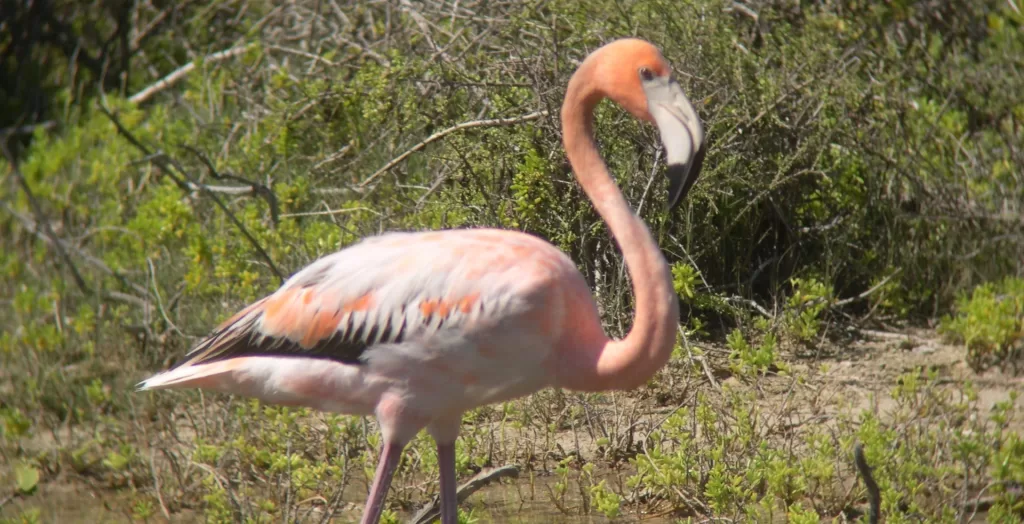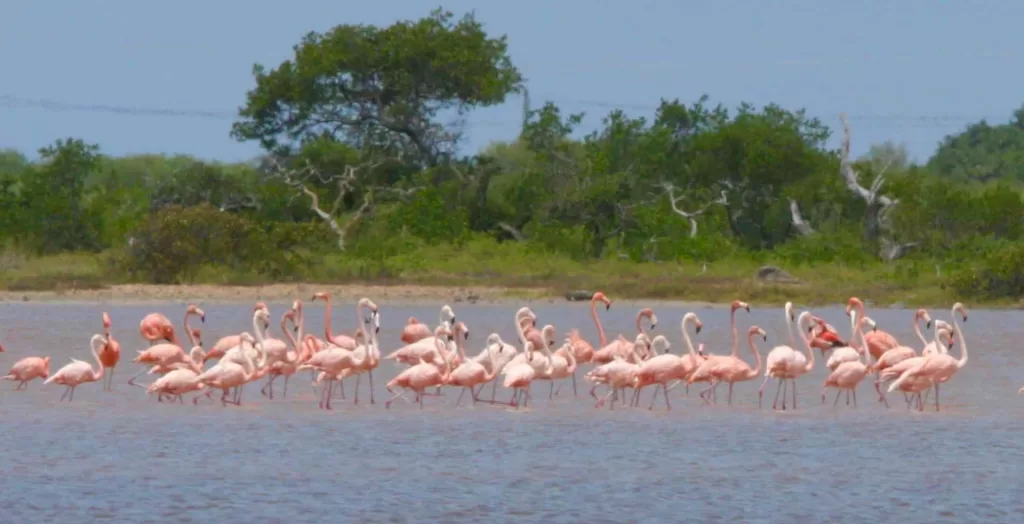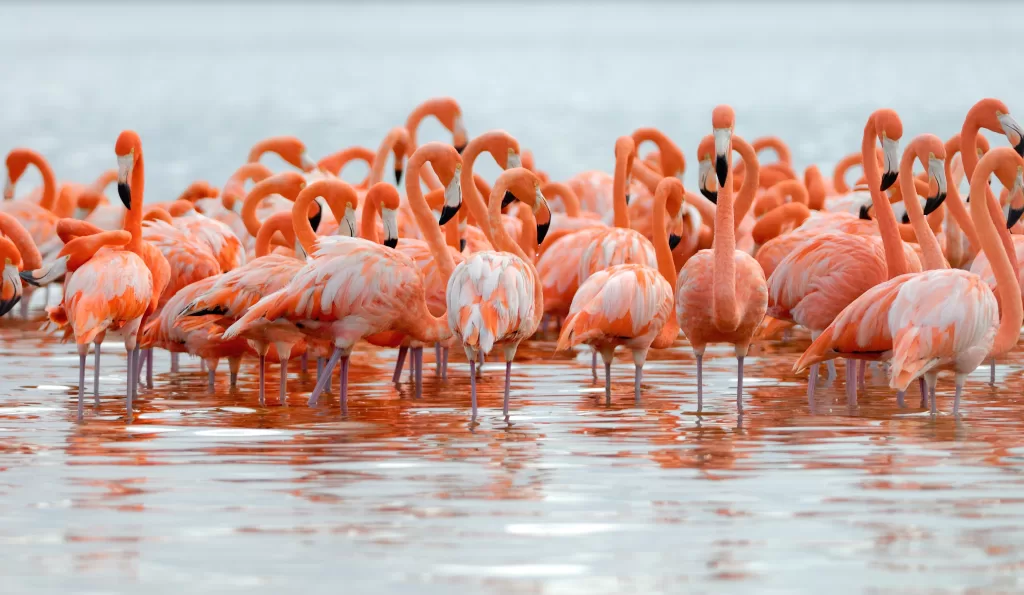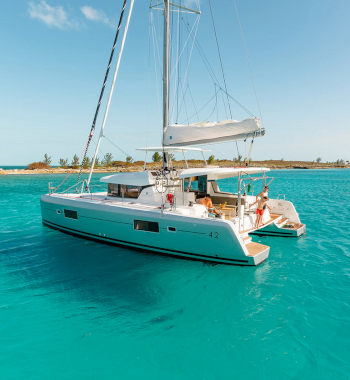The Fantastic Flamingo and its Journey Back to The BVI
By Claudia Colli
Salmon pink and of elegant stature, the roseate flamingo has been a fixture of Anegada, the BVI’s northernmost island, for decades. So, I was particularly interested in learning that there were flamingos at the salt pond at Josiah’s Bay on Tortola. Like travelers on a spontaneous holiday, flamingos come and go from Tortola salt ponds. A while back, for example, six flamingos were spotted on the Belmont salt pond on Tortola’s West End. And whenever flamingos are spotted beyond their home turf of Anegada, it causes a flurry of excitement.

Brine shrimp are the roseate flamingo’s favored food, and one can only guess that there must have been a feast of these tasty little creatures at this West End pond. A day or two later the Belmont visitors were gone, most likely returning to Anegada.
The large flock of flamingos that inhabits Anegada’s salt ponds is a major attraction for BVI visitors and residents. There are flamingos on Necker and Guana Islands, and as recently witnessed, occasionally on Tortola’s Belmont pond.
But this wasn’t always the case. Their presence in the BVI has risen and fallen over the years. At one time plentiful, by the 1950s they had all but disappeared from the region.
The roseate or greater flamingo (Phoenicopterus ruber) once numbered in the tens of thousands on Anegada. This amazing sight was described by Sir Robert Hermann Schomburgk, a German born British naturalist who travelled to the Americas in 1829. The expedition included a trip to the Virgin Islands and Anegada in 1830. Traveling to the Virgin Islands in the early 19th century must have been an extraordinary adventure, especially one capped off by a journey to Anegada, the most remote of the Virgin Islands.
Anegada, a low-lying island rimmed by white sand beaches, has several salt ponds at its center. Rich in brine ship, the ponds are a perfect habitat for the flamingo. It is fun to note that Flamingos get their pink color from their food. Microscopic algae that brine shrimp eat are filled with carotenoids which give certain foods like carrots their orangish color. As a flamingo dines on algae and brine shrimp, its body metabolizes the pigments — turning its feathers pink.
Schomburgk was amazed by the vast numbers of flamingos on Anegada, a sea of pink that filled the salt ponds and dominated the sky when they took flight. But in a chronicle that he later made of his trip he noted that their numbers were declining. They continued to decline throughout the remainder of the 19th and first half of the 20th centuries, falling prey to hunters who killed them for their meat and the extraordinary feathers used to adorn women’s hats of the era.
By the 1950s their numbers continued to dwindle, and by the 1960s there were only a few older birds remaining. These soon died off as well, signaling the end of flamingos on Anegada.
But this is a sad story with a happy ending.
Not content with the loss of these magnificent birds, a group of naturalists, government officials and community members banded together to bring the flamingo back to the BVI.

Dr. James (Skip) Lazelle, president of The Conservation Agency, had worked on other conservation issues in the BVI, including the protection of the endangered Anegada Rock Iguana (Cyclura pinguis). By the early 1980s he became interested in reintroducing flamingos to the salt ponds of Anegada. His plan was proposed to the VI Government’s Department of Natural Resources and the Environment and to community leaders in Anegada.
As Lazelle in a paper on the subject stated, “I did not know how difficult and expensive this would be, or that it would take over a decade to accomplish.”
But he persevered. Among those he worked with were the Bermuda Aquarium Museum and Zoo, the National Parks Trust and Dr. Henry Jarecki, owner of the Guana Island a resort and sanctuary for endangered Virgin Islands wildlife such as the Anegada Rock Iguana, red footed tortoise, and soon, the roseate flamingo.
The first group of birds were donated by the Bermuda Aquarium and Zoo, and with excitement and fanfare, were released on Anegada in 1999. Getting the number of introduced flamingos right took some time, since flamingos like to have a minimum community to form breeding pairs. Eventually 22 flamingos were released on Anegada and eight on Guana Island. The birds have since successfully reproduced and according to the Virgin Islands National Parks Trust, “have provided a successful model of species restoration in the region.”
The Flamingos live mainly around Flamingo Pond, with occasional migrations to Anegada’s eastern ponds, along with occasional forays to the salt ponds on Necker and Guana Islands. Today, the birds number in the hundreds.

Flamingos can be shy creature and I have learned from personal experience that when they are aware of people in the area, they will move further along. In order to not disturb the birds, visitors should not attempt to cross the ponds to get closer to the birds.
When on Anegada, the best area to view the flamingos is from a viewing platform on the main road on the island’s south shore. The pond is big, so sometimes you have to scan its outer edges to see them. But once you do, the sight of this beautiful flock that has made such a dramatic comeback, is well worth it.
The Smithsonian National Zoo and Conservation Biology Institute has some fun flamingo facts to share:
To read more about the restoration of the flamingo in the BVI go to these websites
The Conservation Agency
Dr. Skip Lazelle in the Journal of Caribbean Ornithology:
https://jco.birdscaribbean.org/index.php/jco/article/view/566
National Parks Trust of the Virgin Islands:
And to learn more about Anegada
The BVI Insider:






